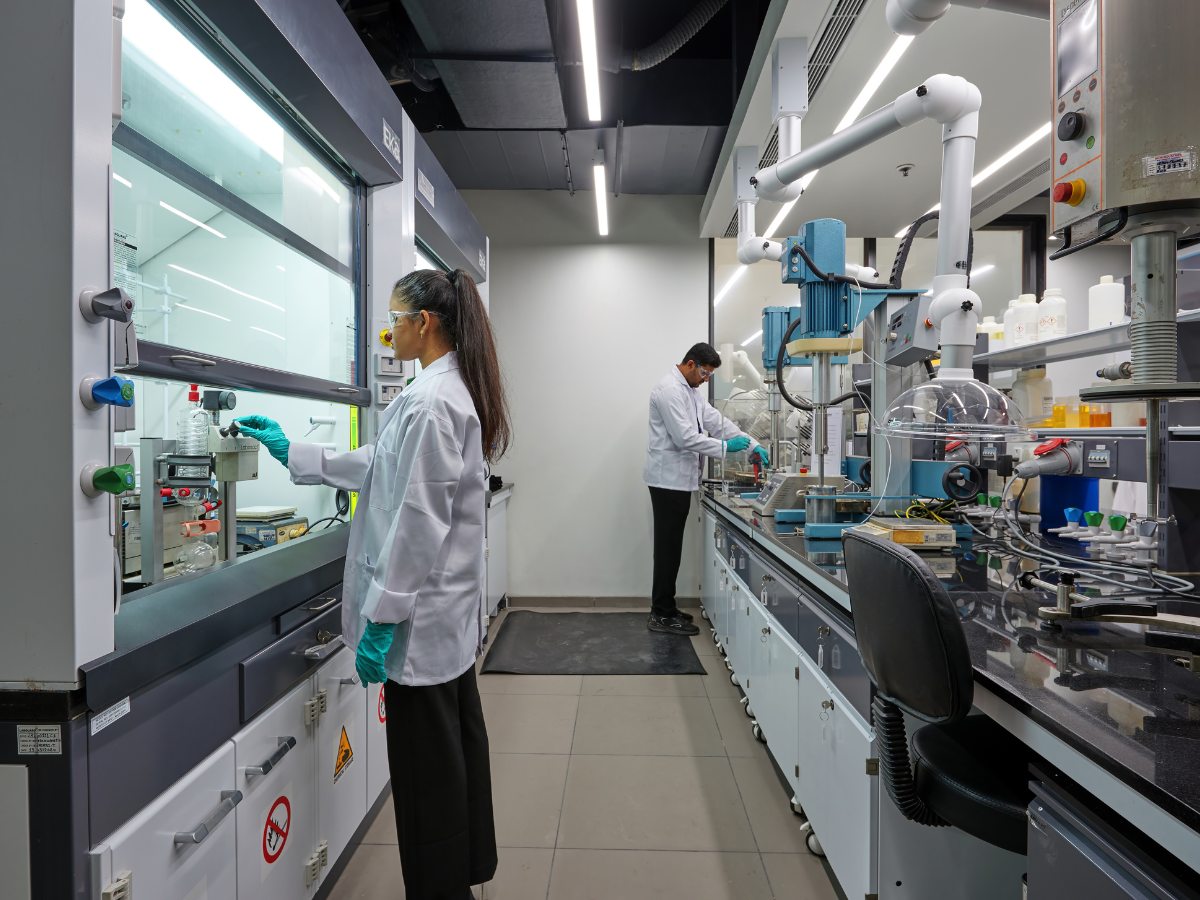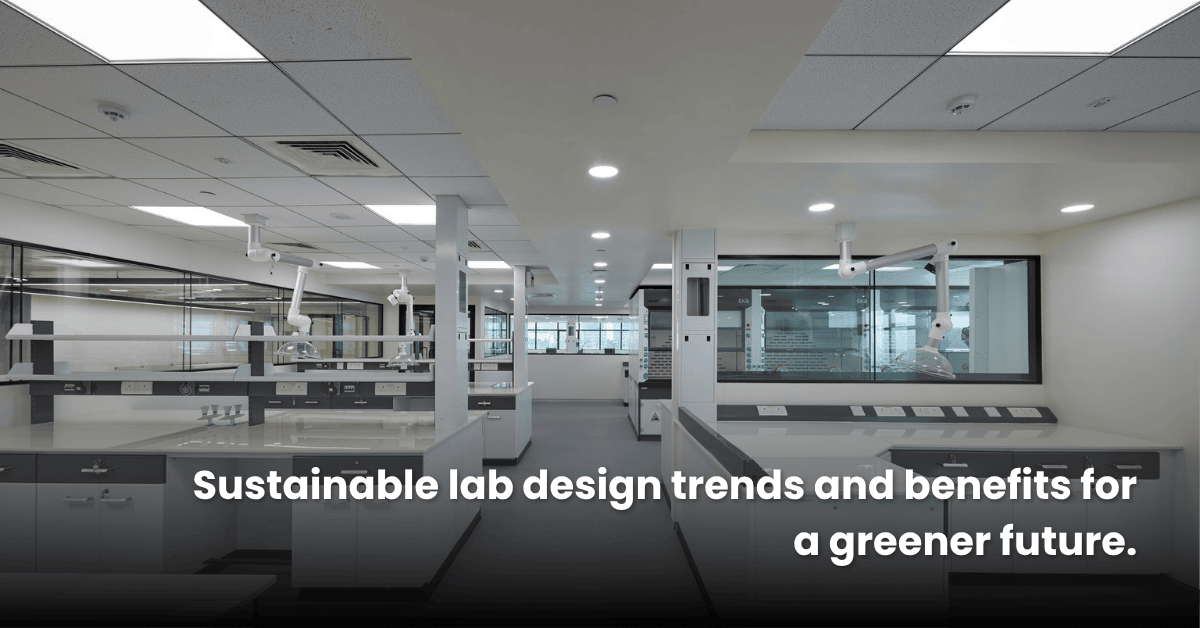As the world shifts towards sustainable practices, laboratories—often energy-intensive and resource-heavy environments—are under increasing pressure to reduce their carbon footprint. According to a Harvard University study, labs consume 5 to 10 times more energy per square foot than an office space, making sustainability a critical priority in modern lab construction.
This guide explores eco-friendly lab design trends, the benefits of green lab initiatives, and how sustainability aligns with global goals like the UN’s Sustainable Development Goals (SDGs).
In this article we have covered
Why Sustainability Matters in Lab Design
The Environmental Impact of Laboratories
- Labs account for 4-5% of total global energy consumption (Harvard Office for Sustainability, 2021).
- A single lab fume hood consumes as much energy as three U.S. households annually.
- Labs produce significant hazardous waste, including chemicals, plastics, and biomedical materials.
Sustainability and the UN’s Sustainable Development Goals (SDGs)
A well-designed, eco-friendly lab contributes to multiple SDGs, including:
- SDG 7 – Affordable and Clean Energy: Energy-efficient lab infrastructure reduces electricity consumption.
- SDG 9 – Industry, Innovation, and Infrastructure: Promotes green buildings and sustainable industrial practices.
- SDG 12 – Responsible Consumption and Production: Reduces waste generation, water usage, and hazardous emissions.
- SDG 13 – Climate Action: Low-carbon and renewable energy-based labs minimize environmental impact.
By integrating sustainability into lab design, organizations align with global environmental goals while improving efficiency and cost-effectiveness.
Key Elements of Sustainable Laboratory Design
A truly eco-friendly lab incorporates multiple sustainability-focused design elements:
A. Energy-Efficient Systems
- HVAC Optimization: Implementing smart ventilation controls to reduce energy waste.
- Fume Hood Efficiency: Using High Performance fume hoods, which reduce energy usage by up to 40% compared to Constant Air Volume (CAV) systems.
- LED Lighting Systems: Consuming 75% less energy than conventional fluorescent lights.
- Ductless Fume Hoods: Using ductless fume hoods reduced the energy usage by 90%
B. Water Conservation Strategies
- Closed-loop water systems for cooling lab equipment to reduce wastewater.
- Rainwater harvesting for non-potable applications like cleaning and landscaping.
- Low-flow laboratory faucets and fixtures reducing water consumption by 20-30%.
Example: Harvard University’s Living Lab Program saved 2 million gallons of water annually by retrofitting labs with low-flow systems.
C. Sustainable Materials & Waste Reduction
- Use of Recyclable & Non-Toxic Materials:
Steel and FSC-certified wood for lab furniture. Low-VOC paints and adhesives to improve indoor air quality. - Plastic Waste Reduction:
Switching from single-use plastics to reusable lab materials.
Implementing autoclaving and sterilization to extend equipment lifespan.
D. Renewable Energy Integration
- Solar-Powered Labs: Generating 40-60% of energy needs through solar panels.
- Geothermal Heating & Cooling Systems: Reducing HVAC energy demands by 30%.
- Net Zero Labs: Fully powered by renewable sources, eliminating dependency on fossil fuels.
Example: The National Renewable Energy Laboratory (NREL) in the U.S. runs on 100% renewable energy, setting a benchmark for green labs.
Trends Driving the Future of Sustainable Lab Design
A. Smart & AI-Driven Lab Management
- IoT-enabled energy monitoring to track real-time usage and optimize performance.
- AI-powered predictive maintenance to minimize downtime and waste.
- Automated air quality sensors ensuring optimal fume hood containment without excess energy waste.
B. Modular & Prefabricated Laboratories
- Modular labs use 30% fewer materials compared to traditional construction.
- Prefabricated sections reduce on-site waste and speed up installation.
- Portable lab structures enable reusability and scalability.
C. Circular Economy in Lab Design
- Recycling & Reuse of Lab Equipment: Encouraging equipment sharing and refurbishment to reduce waste.
- End-of-Life Material Management: Designing labs with deconstructable materials for repurposing.
- Lab Take-Back Programs: Manufacturers reclaiming used lab furniture and materials for recycling.
Financial & Operational Benefits of Sustainable Labs
A. Cost Savings & Payback
- Energy-Efficient Labs Reduce Costs by 30-50% (Harvard Green Labs Study).
- LEED-Certified Labs save an average of $0.50 per square foot in annual operating costs.
- Payback on Sustainable Investments:
LED Lighting → Pays back in 2-3 years.
Water Recycling Systems → Pays back in 5-7 years.
High Performance Fume hoods → Pays back in 1-2 years.
Ductless Fume hoods → Pays back in 1-2 years.
B. Compliance & Brand Reputation
- Meets global regulatory standards (LEED, WELL, ISO 14001).
- Attracts research funding & grants from green energy and sustainability-focused programs.
- Enhances brand image as a leader in eco-friendly research practices.
C. Employee Productivity & Well-Being
- Improved indoor air quality reduces sick days by 20% (ASHRAE Study).
- Daylight exposure enhances researcher focus and efficiency.
- Ergonomic & biophilic design fosters creativity and collaboration.

Challenges & Solutions in Implementing Green Labs
| Challenge | Solution |
|---|---|
| High Initial Cost | Leverage government incentives & green building grants. |
| Resistance to Change | Implement Green Lab Training & Awareness Programs. |
| Space Limitations | Use modular, space-optimized lab designs. |
| Compliance with Multiple Standards | Work with turnkey lab partners specializing in regulatory compliance. |
Conclusion: The Future of Sustainable Lab Construction
Sustainable laboratory design is no longer optional—it is essential. By integrating energy-efficient systems, water conservation measures, and smart technologies, organizations can reduce operational costs, enhance researcher productivity, and contribute to global sustainability goals.
Key Takeaways:
- Green labs align with SDG goals for climate action and responsible consumption.
- Smart energy systems can reduce lab energy consumption by up to 50%.
- Modular construction & circular economy approaches minimize waste and costs.
- Investing in sustainability enhances funding opportunities and brand reputation.
Looking to Build a Sustainable Lab?
ScienceByDesign specializes in eco-friendly turnkey lab construction, delivering green-certified, high-performance laboratories.
Contact us today for a sustainability consultation!

